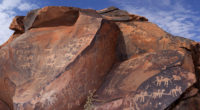Sites
- Al UlaAl Ula, located about 380 km north of Medina, used to be an important trade center for a major caravan route. At Al Ula, the road branched, with one arm leading to Babylon, via Tayma, and the second to Petra and Syria.
- TaymaThe oasis of Tayma, is located in the Province of Tabuk, 220 km southeast of the city of Tabuk. Tayma occupies a relatively flat basin on the western edge of the al Nafud desert, to the east of the Western Shield area that includes the volcanic crest known as Harrat al'Uwayrid. North of the settlement of Tayma is a large seasonal salt pan (sebkha), formed by a lake in the early Holocene.
- Mada'in SalehMada'in Saleh was an important stop on the Incense Trail, and although camels provided most of the transportation of goods, the horse was also used by individual riders.
- JubbahThe oasis of Jubbah is the remnant of an ancient lake that was rich in wetter periods with people, flora and wildlife. Today, owing to the relatively high water table and modern hydrological technology, Jubbah is a rapidly growing town.
- Ha'il RegionThe province of Ha'il is incredibly rich in rock art, with major and minor sites sprinkled over much of its territory. Around the modern city of Ha'il, countless individual rock outcrops containing only one or two panels of art can be found.
- ShuwaymisShuwaymis is an area about 370 km southwest of the city of Ha'il, near the town of al-Ha'it. The petroglyphs were known by local Bedouin for centuries, but only drawn to the attention of authorities by a local school headmaster, Mamdouh al Rasheedi, in 2001.
- Qaryat Al-AsbaQaryat al Asba, known to the West as Graffiti Rocks, is about 100 km west of Riyadh, near the highway exit for Musayqirah. Geologically, the formation is an inselberg (isolated outcrop), prominent in the open plain surrounding it. To the east is a north-south trending ridge that apparently has less significant images carved into the rock.
- Bir HimaThe region around the modern city of Najran, in southwest Saudi Arabia, has much to offer in terms of this research. In January of 2010, we documented many of the petroglyphs in the Bir Hima area, including numerous fine images of mounted cavalrymen on horses that appear to be of the Arabian breed.



This map uses satellite photography from Google Earth, which uses data from the U.S. Geological Survey.
-
Al Ula
Al-'Ula oasis is located in the verdant Wadi Al-Qura, or “valley of villages,” approximately 110 km southwest of the modern city of Tayma and 380 km north of Medina.
-
Bi’r Hima
The region around the modern city of Najran, in southwest Saudi Arabia, has much to offer in terms of rock art research. The settlement of Najran was an important center along the Incense Route. Caravans originating at the source in Yemen passed through Najran before turning northward.
-
Ghouwtah
Ghouwtah is a petroglyph locality that is a few kilometers east of Jubbah, just slightly south of the main road that heads due east out of the town. It has two main petroglyphs, both of which appear to be later in age based on the writing, subjects and style. The first, which we call Split Rock, has camels, oryxes, a canid, ostriches, and people who are either fighting or playing games.
-
Ha’il Region
The province of Ha’il is incredibly rich in rock art, with major and minor sites sprinkled over much of its territory. Around the modern city of Ha’il, countless individual rock outcrops containing only one or two panels of art can be found. The predominant subjects of these are horses and camels. The areas around Shamli, 170 km south of the city of Ha’il, and Yatib, about 35 km [...]
-
Jubbah
Two regions are known to contain the best and oldest examples of Neolithic rock art: Jubbah, northwest of the city of Ha’il - and Shuwaymis, southwest of Ha’il and near the town of al-Hayit. Of these two, Jubbah is the best known and most published.
-
Mada’in Saleh
Mada’in Saleh, not far from al-Ula (22 km), was known as al-Hijr, or Hegra, by the Nabataean people who carved its magnificent tombs into the golden Quweira sandstone outcrops. The delicate details on the entrance portals and the smooth surfaces of its 111 tomb façades reflect the great skills of the masons of their time.
-
Qaryat al-Asba (Graffiti Rocks)
Qaryat al Asba, known to the West as Graffiti Rocks, is about 140 km west of Riyadh, near the highway exit for Musayqirah. Geologically, the formation is an inselberg (isolated outcrop), prominent in the open plain surrounding it. To the east is a north-south trending ridge that apparently has less significant images carved into the rock.
-
Qatar Cave
Qatar Cave is located on the north side of the Jebel Qatar, a large pyramidal mountain. The cave, which is more than halfway up the steep slope, has a remarkably well-preserved scene showing several men with their herd of sheep and goats confronting wild cattle with bows and arrows.
-
Shuwaymis
Shuwaymis is an area about 370 km southwest of the city of Ha’il, near the town of al-Ha’it, in southern Ha’il province. The petroglyphs were known by local Bedouin for centuries, but only drawn to the attention of authorities by a local school headmaster, Mamdouh al Rasheedi, in 2001.
-
Tayma
The oasis of Tayma is located in the Province of Tabuk, 220 km southeast of the city of Tabuk. Tayma occupies a relatively flat basin on the western edge of the al Nafud desert, to the east of the Western Shield area that includes the volcanic crest known as Harrat al ‘Uwayrid.









